ALLIGATOR
BEHAVIOR page 6g: ON LAND; WALKING AND BASKING page 7 page 1 2 3 4 5 6 8 9 10
This
page was born 07/19/2008. Rickubis designed it.
(such as it
is.) Last update: 09/24/2022
Images
and contents on this page copyright ©2001-2022 Richard M. Dashnau
Alligators
are amphibious (but not AMPHIBIANS) and are in the water
most of the time.
Therefore it is worthy of note when they are
on land, especially
when they are doing more than just absorbing solar
energy. Here is yet another page of terrestrial alligator
antics.
From Brazos Bend State Park
on 08/28/2022 Some
hours
after the action with the gator mom on Spillway Trail
(described
elsewhere), this alligator was foraging
near
the Observation Tower in water that had reappeared in Pilant
Lake.
Although a few small fish and occasional tadpoles were
visible,
there was a lot less activity in the water than usual.
The alligator
had mud all over the top of its head, a really big lump of mud
on the
back of its head. A small dragonfly used the mud as a
perch
while
the gator slowly cruised around. The gator
submerged briefly, then
moved East, and towards the common crossing spot (I saw many
gators
leave the lake at that point-a few yards East of the restored
culvert-over the last month or so.).
Since it appeared that the
hunting was poor, I thought there was a good chance that this
one would
cross too, so I moved a bit past that point (to get the
sun
behind me) and turned to watch.
A few minutes later, a group
of 8 visitors walked up, and I got their attention and
suggested that
they watch the area near me. The gator crossed, to the evident
enjoyment of the group. The
people kept far back from the
crossing gator. After the gator had crossed, I was able
to
talk
to the folks, who were mostly new visitors to the park (two
were
visiting from Northern U.S.).
Sharing experiences like this
with park visitors-especially those new to the park-is one of
the
biggest rewards for working at BBSP,
When
I've seen an alligator's head covered with mud like this, it
was pretty
obvious that the alligator had been burrowing (because I had
seen it
using the burrow). With so much mud on
top of its head, I
think that this alligator had been burrowing or moving in
and
out
of a burrow( or den); or, the alligator had buried itself in
the soft
mud.






Here's
something that appeared on 40-Acre Lake trail on 10/10/2021.
Yes, it's feces, poop, scat, or stool. At first thought,
it is
just evidence that an animal left a "sculpture" on the trail.
But, this
sculpture was left by an alligator. Since most people
aren't
lucky enough to move around in alligator habitat; most people
don't get
to see this. Usually, I have to identify
the scat by size, color, texture, etc.. But this
sculpture was signed by the "artist"! That squiggle on the
trail
leading to it(or from it) is a drag mark left by the alligator's
tail.
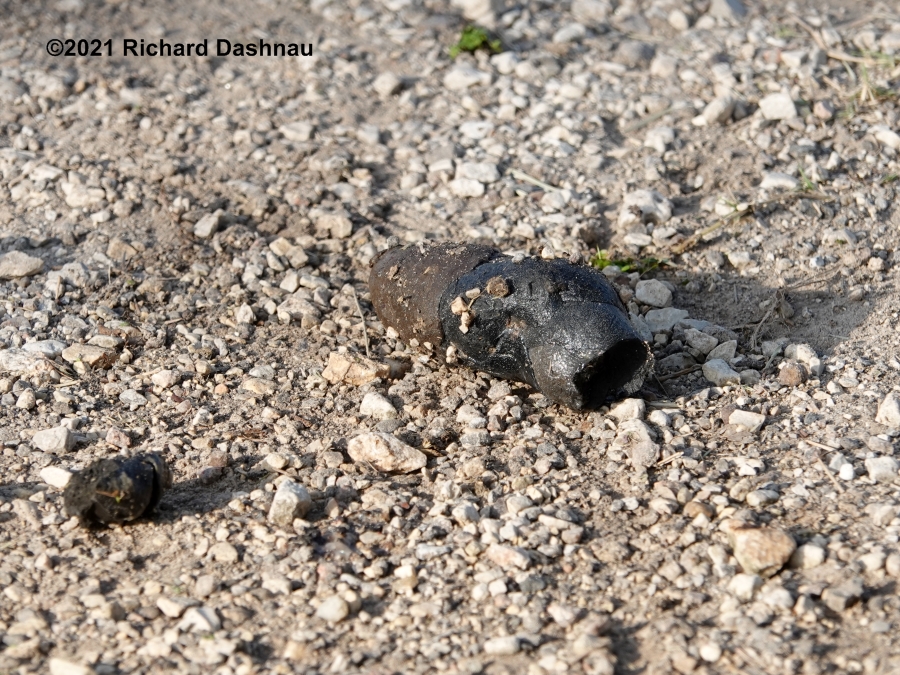
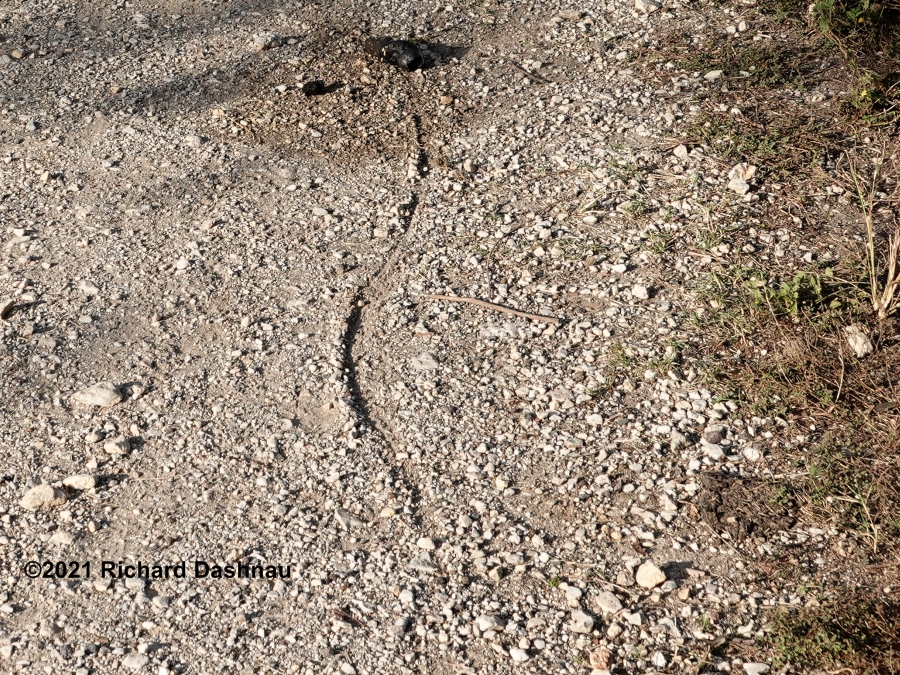
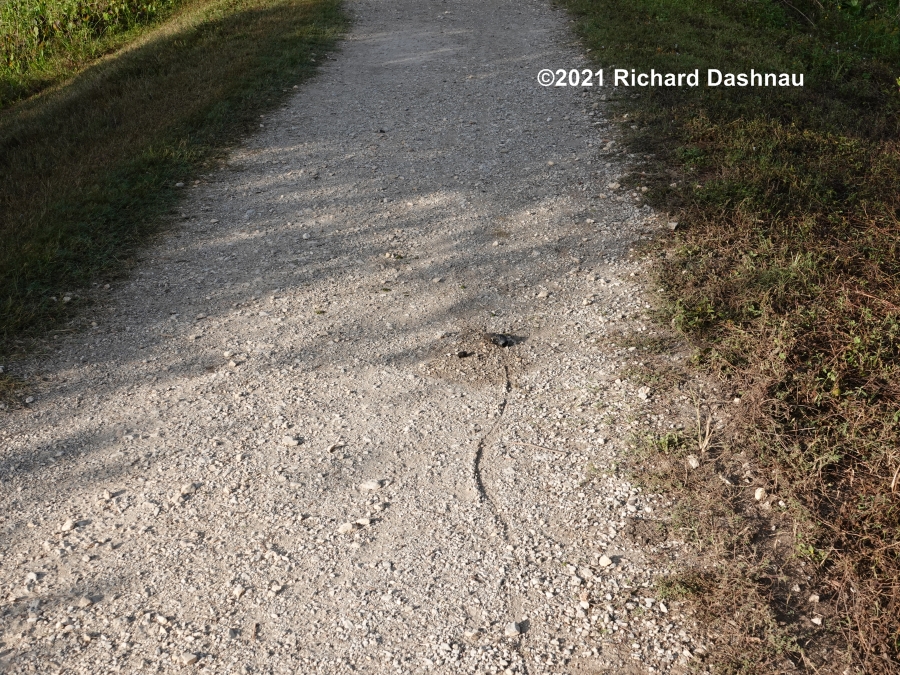
05/02/2021 Even
with more "spare time" it's taking me days to work on new material so I
can post it. Part of the reason is that I get more
new material before I've completed
editing of the previous new material--because I have more of that "spare
time" to go get the new material. Oh, darn. LOL
So, here's how my morning went at Brazos Bend State Park on 05/02/21.
I have more
photos (and some video) but I need to post this now before much more
time passes (it's
already
been a week today). I'd just gotten to the edge of 40-Acre Lake
(had just walked down the hill) when,
I saw this alligator cross the trail about 50
yards or so ahead of me
(far enough to be around the bend so I could
get this far shot).


This
alligator crossed ahead of me.
When
I got to that bend, I saw an alligator near the island that seemed to
be chewing on something. The alligator that had crossed the trail went
out to meet it. A chase of
alligator vs. alligator ensued.
(I've got a video of this, and a series of captured images which I will
post later). But events (to be described) finally resulted in a
different
alligator on the trail (which, it turned out, was a male
(also evidence in video). I spent a few hours standing near it, and
doing general interpretation for visitors that came by.




The
alligator came in slowly.
Then
paused near the other gator. The
trail there is about 6 feet across.
Zoomed in closeup shot.
The
alligator shifted on the trail, finally turning around.
Eventually, it started to gape--I assumed this was a "thermal
gape" which showed that the alligator was getting overheated.
About
10 minutes after, the alligator went back into the water. I'd spent
about 2 hours with it. A wonderful morning at the BBSP.



The
alligator turned around.
Probable
thermal gape
The returning to the
water!
03/04/2021 I
visited Fiorenza Park North again. It's not too far from home.
I'm not sure, but I think the water level has dropped since my
last visit.
Today, I discovered that the armored catfish (various
species?) apparently did not come through the freeze even unscathed.
There were many dead ones
scattered around the shoreline.
There were many different sizes. Maybe they had died during
the freeze but their carcasses had been hidden by deeper water.
They
were certainly visible today!
There
was one other animal at the park. It's an animal that I've become very
familiar with at Brazos Bend State Park, but they aren't common
everywhere else. It's an alligator! I've only seen alligators
at Fiorenza park on one or the other of the two islands to the North of
Westpark drive. Below are three images I shot
today, at different
zoom levels, to show location.


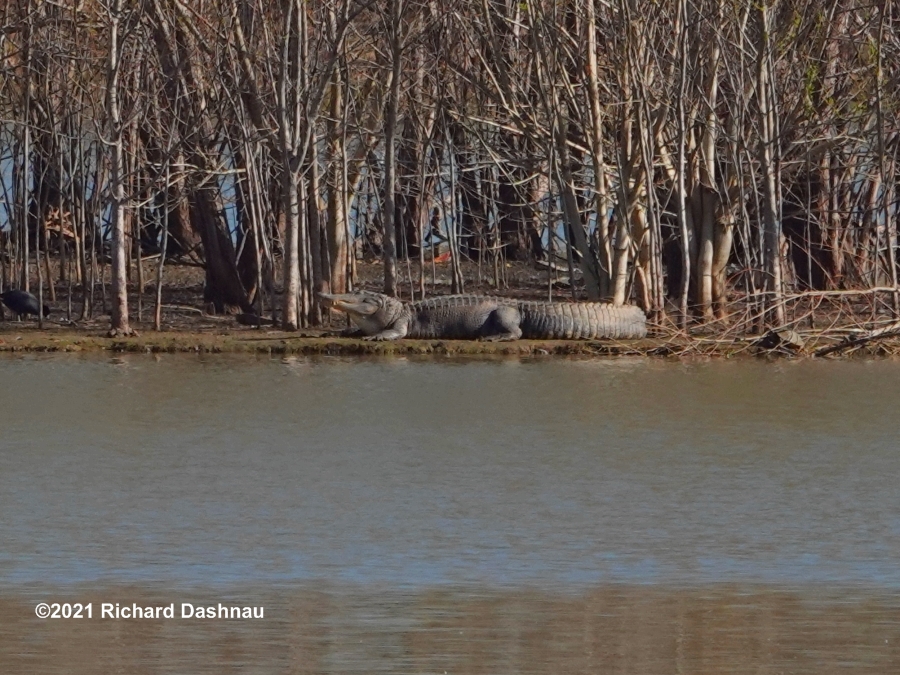
07/28/2019 Just
a
quick clip of an alligator crossing the trail. I was heading
East on
the Spillway trail, and at the East end of the Spillway Bridge,
I
walked by a park
visitor
that was watching an alligator in Pilant Lake, near the trail. I
few
steps further on, I saw another alligator facing the "island
humps".
Another park visitor
was walking towards me (he was walking West).
I had stopped to talk to him, when there was a splash as
the
alligator jumped. The visitor had been watching the
alligator,
and it appeared to have not caught anything. While I was
talking
to this visitor, I noticed that the alligator had moved back
towards
the trail (moving South,
towards us). Then, it began climbing
up the bank in a line that would have taken it over the spot
where we
were standing. Figuring that it wanted to cross, I asked
the
visitor
to move to either side of the gator's apparent path so it would
cross.
The visitor moved East, and I did, too. The
alligator came
up and crossed the trail. The
other visitor that I'd passed,
hurried over to shoot video of the crossing. I shot video,
too,
but only after the gator had begun crossing. I had to be sure
that we
were
out of the gator's path before I started shooting video or
photos. The images below show the alligator at
mid-crossing,
with
a good comparison with the width of the
trail--it's a frame grab
from the video. The other picture shows my stick after I walked
over
and placed it over the trail-drag mark from the gator's
crossing. I got
as
close as I could to my original filming position and took the
picture for comparison. My stick is about 6 feet long (it's 71.5
inches
actually). It looks like the alligator was
8 or 9 feet long.
I'm posting this because it shows how the alligator had no
wish
to be near us (I'm sure it was aware of us), and just intended
to cross
the trail.
Here's
the video.
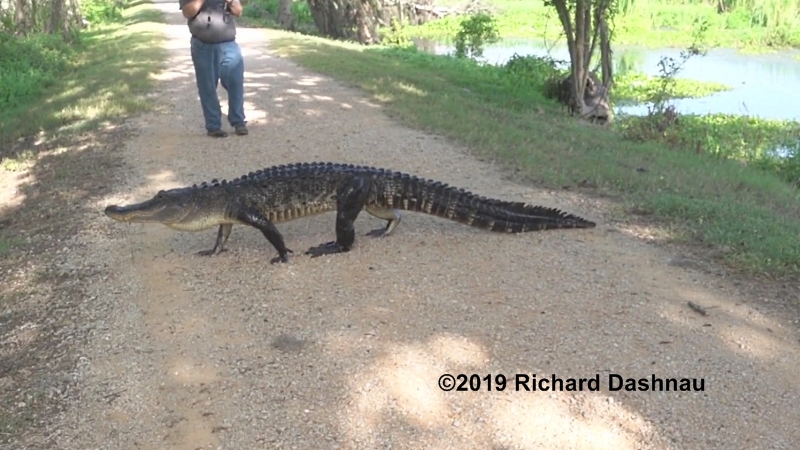
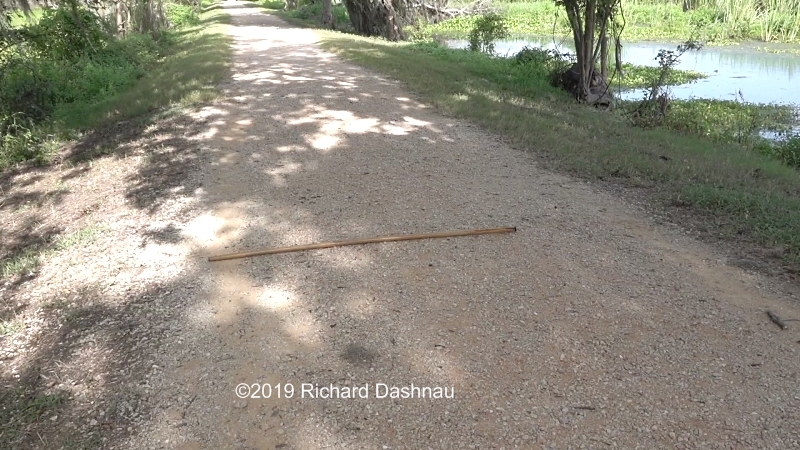
12/09/2018
The sky was gray. The water in the lakes at BBSP was clear, and
a bit
high--since it had rained heavily 2 nights before. The air
temperature
was 40� F.
In short, this was what I would call "Otter
Weather". That is, weather where it might be more likely
that
Otters would be on the move. At least, that is what I
thought my
experience has taught me. By the way--the same weather
conditions might
also be better for seeing Bald Eagles as they visit the park.
So,
I was moving East on the North side of the 40-Acre Lake trail,
and I
was scanning the the sky, the treetops, and the water for Eagles
and
Otters.
I was dressed in layers of insulating clothing which kept me
warm
against the cold wind that blows South off of Pilant Lake.
So,
I was really surprised to see an Alligator on land, and crossing
the
trail, about 100 yards ahead of me--at the popular crossing spot
just
West
of the Observation Tower. I quickly lifted my camera and
snapped a quick burst of pictures. The alligator stopped briefly
and
rested.




But,
it moved off the trail and into 40-Acre lake before I'd gone a
few
steps. This was just another example of an alligator doing
something unexpected,
as they seemed to be doing lately. Considering
all the cold weather we've been having, it seems that alligators
shouldn't be moving around much;
or even eating.



------------------------------------------------There
it
is, just over 40�
F------------That's
my 6 foot long "walking" stick where gator crossed.
But
Alligators
had been seen over the previous weeks with prey in their
jaws. I even saw one on 11/25/2018! It took a while to
figure
out what the Alligator had, but there it is. That looks like the
back
leg and claws of a Nutria to me. That was during another
bout of cool weather, too (temperature 55 - 60 F)



But
was this activity really that odd? Sure, it was cold on
December
9th. And also on November 25th. But this is a chart
I made
of the low and high temperatures
that were measured in Sugar Land,
Texas and collected on the NWS website. Sugar Land is
about
15
miles straight North of Brazos Bend State Park, so the
temperatures
between
the two should be pretty close. Considering that the water
in
our
lakes does not move around much (no streams or springs
continually feed
them), Heavy
rain runoff could disturb any temperature or chemical
layers in the lake water--but the lakes should be pretty stable.
I
think it's possible that the lakes are
gaining enough heat on the
warm days to stay quite a bit higher than the cold air
temperatures
we've had so far. The chart is surprising.

06/03/2018 Although
I don't upload new pictures every week, that doesn't mean that I
don't
see something interesting every week. There is almost always
something
worth sharing happening here. It's just that the web space I'm
renting
is limited (though large),
Having said that...here are a few things from from June
03, 2018.
If
one walks trails early in the morning--animal traces like
footprints
are easier to see, since the low elevation of the sun throws
such
traces into high relief. The
shadowing of the prints makes them
stand out. This effect wanes as the sun rises in the sky.
On
this
morning, I walked East on the North part of the 40 Acre lake
trail.
I encountered a number of alligator tail drag marks. When an
alligator
high-walks across a trail, usually the tail leaves a distinctive
mark--almost appearing
as if the trail was scored by a dull knife. Usually footprints
don't
show in the crushed stone on most of the trails, in part-I
believe-because the feet allow the
weight
of the alligator to be spread over a wider area. This morning,
however,
I saw this crossing pattern, which also showed the faint
impression of
feet.
(gator track 1) The stick in the photo is my "walking stick",
which is 71.5 inches long. About 15 minutes later,
I
encountered another crossing--also with foot
impressions (gator
track 2). Note that I am walking East, so the shadows are
towards
me. I might not have seen these if I had been walking in the
opposite
direction.
Finally after another 10 minutes of walking, I found a very
popular
crossing spot, about 20 yards West of the Observation
Tower.(gator track 3).
I believe that these tracks were all made
some time during the night or early morning; since they are
quickly
obliterated by daily foot traffic and would not
have lasted while
people were walking the trails. An interesting note is that some
weeks
ago, I watched a Red-ear Slider lay eggs on the North side of
the trail
in
area shown by image 3. That is on the right of that image. There
were
drag marks evident then, too, and I thought that there was a
good
chance that that nest
would remain undisturbed by whatever creatures
plunder the turtle nests. Finally, about 30 minutes later, a
small
alligator (about 4 feet long) crossed the trail
in the same area. (gator trackmaker)




GATOR TRACK 1
GATOR TRACK 2
GATOR
TRACK 3
GATOR TRACKMAKER
04/15/2018 . At
Brazos
Bend State Parkout it was nearly 60 � F. I'd been on
the
trails about 90 minutes. I had seen a few alligators in
another
lake, with just the heads exposed. The air temperature
(which I
measured), was about 54 degrees F then. Then,
I noticed this alligator surface in Elm Lake (041518_01). It had
been
submerged in water at least 8 feet deep. When I checked,
the
air
temperature was just above 60 F (041518_02).
The alligator began swimming, with its back showing at the
surface (041518_03).
I followed the gator to a popular basking spot, and talked to
some
of
the park visitors that passed by.



041518_01
041518_02
041518_03
I
told them that I expected that alligator to come out on the bank
soon.
I waited for about 20 minutes (which isn't really "waiting",
since I
could watch other animals and birds moving around). That
alligator
didn't move, but suddenly, other gators appeared at the surface.
About 10 minutes later, 3 alligators had come up on the
bank to bask almost simultaneously!(041518_04)
Yes, there are 3 in that picture.
I checked the temperature again.(041518_05)


041518_04
041518_05
Some
hours
later, I was back in town, eating dinner. I was reading a study
(Patterns, Drivers, and Effects of Alligator Movement, Behavior
and
Habitat Use; by Abigail J. Lawson, Bradley A. Strickland
and Adam E. Rosenblatt,
when I read: "As air temperatures warm, alligators begin to
emerge from
their winter den sites and increase their daily movements,
especially
after air temperatures exceed
the minimum metabolic threshold for prey consumption (16
C; Joanen and McNease 1989).
16 C = 60.8F...which is about the temperature I saw.
03/27/2016 I was near the Elm Lake Water
Station, near
a couple
alligators that were basking. There as a large one partially
on
the trail--though mostly on the grass and
facing Elm Lake.
One of the most frequently asked questions visitors on the
trail
as me is: "Is that alligator a male or a female?" There is
almost
no way to be 100-percent sure
of an alligators gender aside from probing its cloaca. And, we
don't do
that. And, we are not going to go over to that
one and do it.
But
there are a few other indicators that can lead to a good guess of
the
gender. For example, if the alligator is watching over a
nest, or
babies, it is probably a female. If it is over 10 feet long,
it is probably a male.
On this
particular day, a person in a family group asked the question, and
I
gave another answer--which I use sparingly, depending upon the
audience. First, I mention that I know
the gender of one
particular male. That alligator normally patrols the area around
the
Spillway Bridge. And, I know it's a male because it showed me
its genitalia. (I have described
that event on my web page here.
Look for the entry dated 5/18/2014.) I had just
described that event to today's
family when the large alligator in front of us
did the same thing.
It stood up, lifted its hindquarters, defecated, and extended its
genitalia. The "cloaca" is a single
opening that is used for access to digestive tract, urinary AND
reproductive organs.
Here
it was being used to access 2 of those functions. It was one
of
those funny coincidences that sometimes rewards trail
interpreters--almost as if the alligator had heard us and
was
obliging us with a demonstration. I took a few pictures to
demonstrate this event, and I also took a few of specific features
so I
could recognize the alligator again. Here is another
that
I can say is definitely a male!
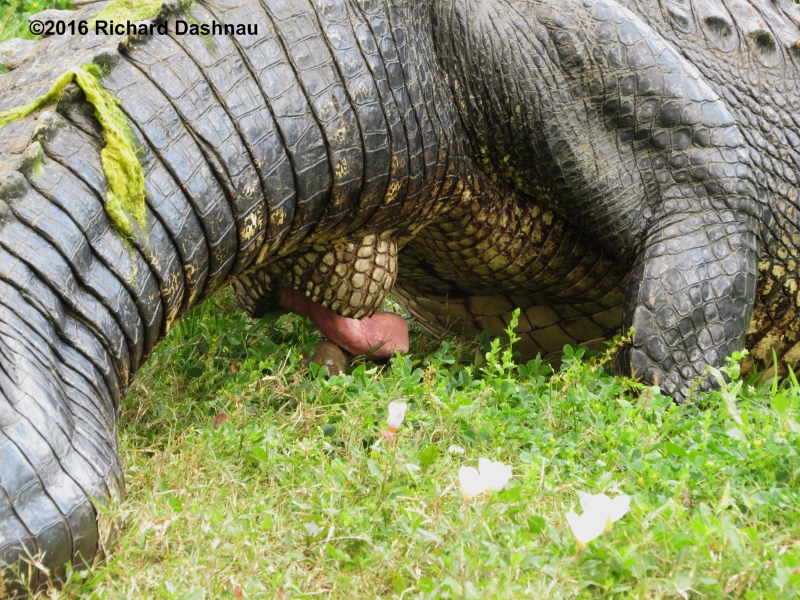
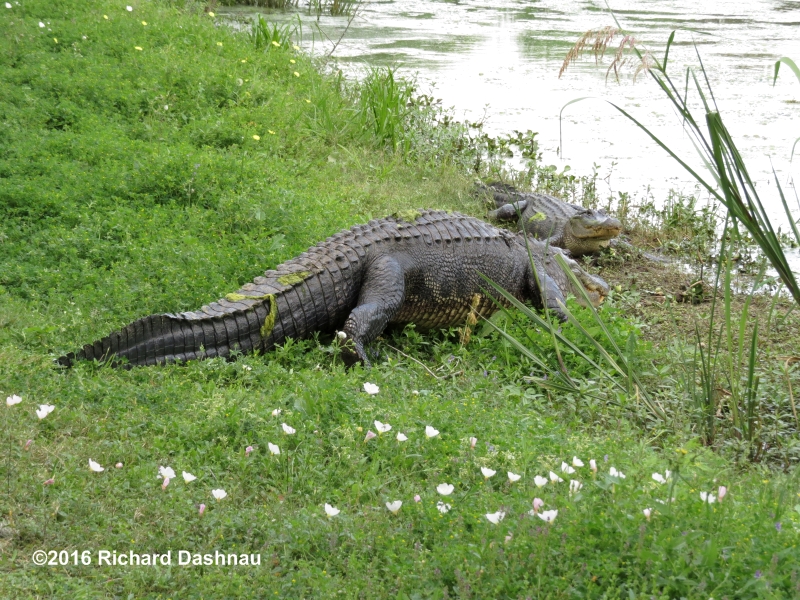
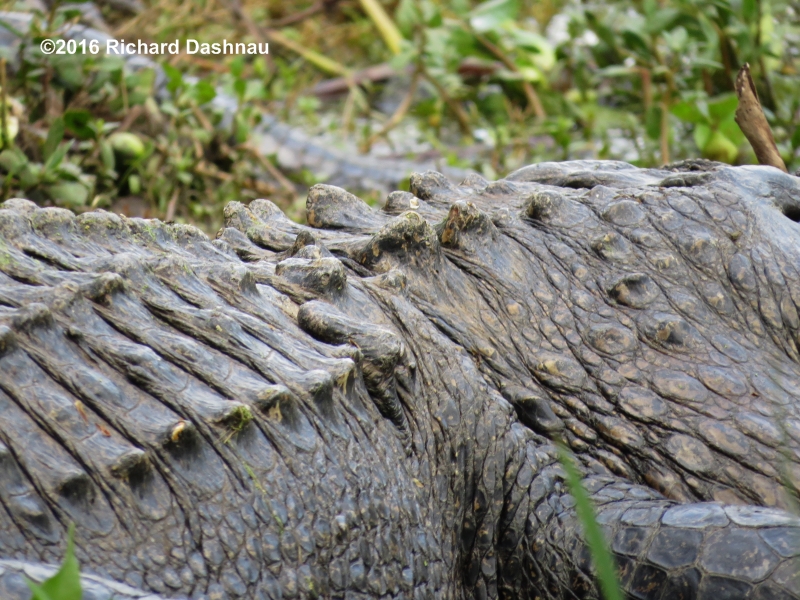
(update 4/14/2016)
Since everything comes out of the cloaca, I wondered if the penis had
to be "moved out of the way" to allow an alligator to defecate. I
looked through my alligator books at home, and
couldn't find anything.
I went online, and finally found this article by Ed Yong. That article
had a link to this paper by Diane A. Kelly: "Penile Anatomy and
Hypotheses of Erectile Function in the American
Alligator (Alligator mississippiensis):Muscular Eversion and Elastic
Retraction". (link here )
According
to those articles the alligator penis is composed mostly of a collagen
core so it is "always" rigid, and curved. This rigid, comma-shaped
organ is "sheathed" by being held inside the hip, above the ischium.
There,
it is covered by the sets of cloacal muscles, and attached to the hip
by two major ligaments/tendons. The penis is extended when the cloacal
muscles flex, which squeeze it out, which eventually stretches at
least
one of those 2 ligaments ( The ligamentum rami. I suspect the
other(ventral penile tendon) may act to stabilize the orgain
as
it extends). This stretches the
ligamentum
rami enough so that when the cloacal
muscles relax, the l. rami *pulls
the penis back into storage*!
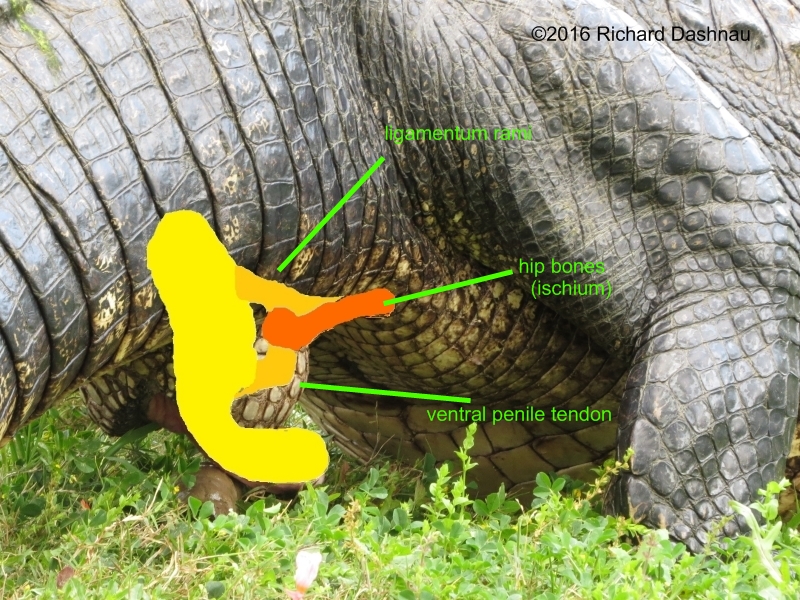
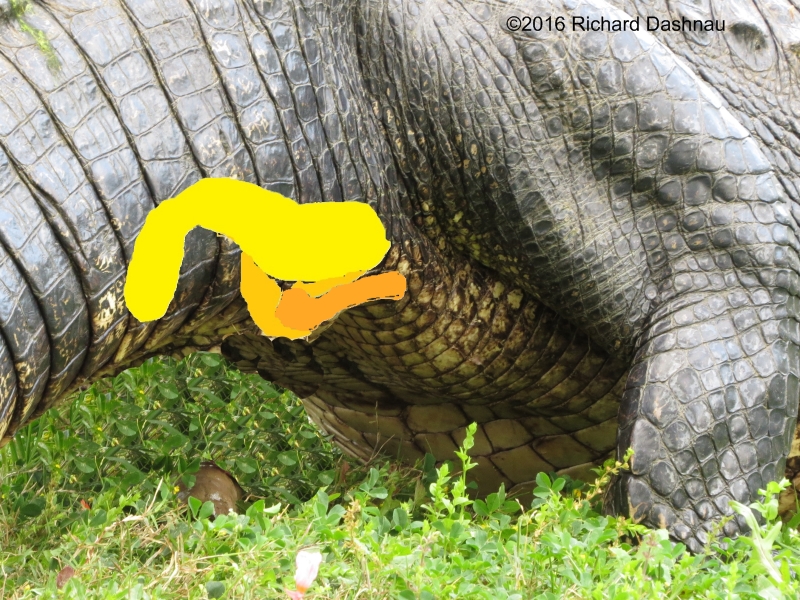
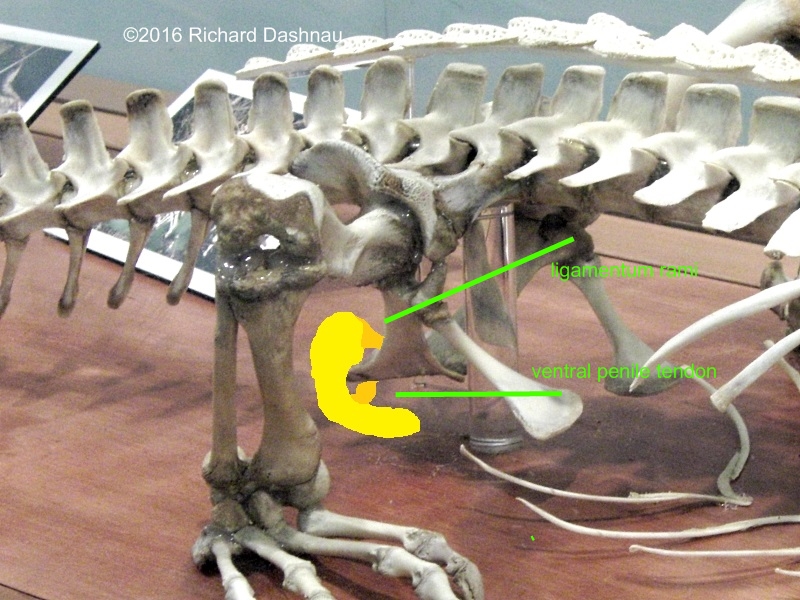
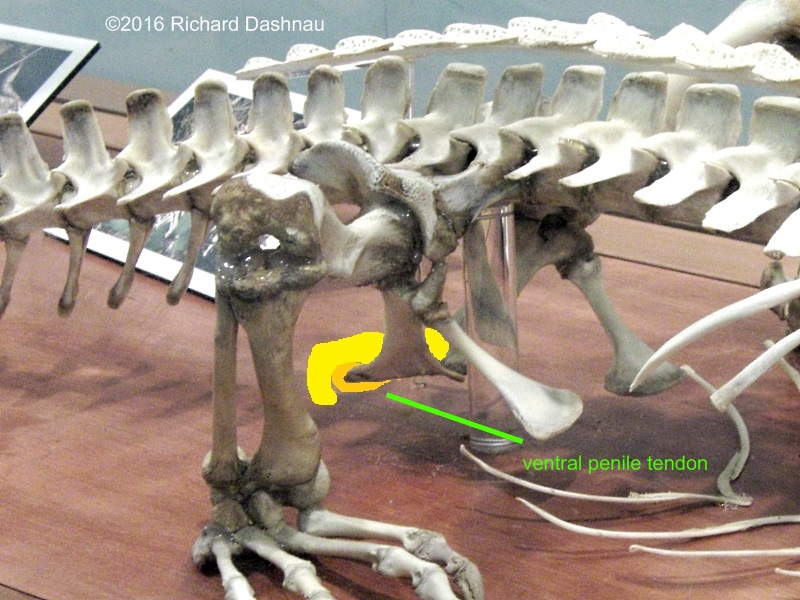
So...if
the cloacal muscles cause this to happen, does this mean that those
same muscles-which may be used for defecation as wel-would always cause
this reaction? This was the only information I could find.
I've
created these images based on photos and figures in the study by Diane
A. Kelly--but I have created these images from my own photos.
11/02/2008--
There's been a bit of activity since my last update. Some
interesting
items,
but all overshadowed by a visit from a hurricane named Ike. I'm
fine.
My
dog, Buddha, is fine. And here is a new story.
We are
beginning to experience the cooler weather of fall. Nights have
become
cooler. The alligators are more active on land, basking and
walking and
generally taking advantage of solar energy.
Previous
visitors to this domain may recall that I bought a small "sport"
video
camera about a year ago. It's a small, self-contained, waterproof
device
that will record video when started until it runs out of memory
or
until
it is stopped. I originally tried using it attached to my dog, and
you
can see details of that on her web page, here.
With
all the alligators crossing the trails, I decided that I'd try to
take
some video footage of an alligator crossing the trail--but from
the
level
of the alligator. I'd need to find an alligator that was preparing
to
cross
a trail.
Then I'd have to do at least three things. First, find an
alligator
that intends to cross a trail. Second, determine the path the
alligator
is going to take. Third, start the camera and place it on the
anticipated
path; but I'd
have to do it without interfering with the alligator.
That
means I'd have to place the camera before the alligator started
moving;
and far enough from the alligator so it wouldn't change direction
or
stop;
and, with a short
enough interval so that the alligator passes the
camera
before it runs out of memory. I wanted the camera to be
unobtrusive,
and
as low as possible, so I couldn't mount it on anything.
While
I was watching some alligators basking at New Horseshoe lake, an
alligator
turned, and I figured that it would be crossing the trail to Elm
Lake.
I decided to--if I could time it correctly--try to place the sport
camera
in the path of the alligator and hope it would walk near or over
the
camera.
I had to do this long before the alligator got close, or else it
would
either change direction (to avoid me) or stop walking entirely.
The
alligator
began walking, and I placed the camera. My timing was good, but I
had
the
camera pointing the wrong way, and the alligator walked past just
barely
in view. The first two images below (GATORCROSS 1 A; and
GATORCROSS 1
B)
show the alligator as it is passing the camera. The small grey
object
(sort
of shaped like a flashlight) is the camera. The third image (OFF
TO THE
RIGHT) shows an image from the video clip.
I was a bit
disappointed,
but not for long. The other alligator had decided to cross, too!
- -
-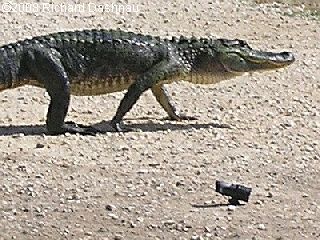 -
-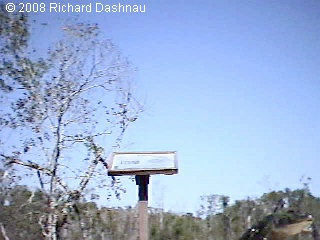
GATORCROSS 1
A
GATORCROSS 1
B
OFF
TO THE RIGHT
This
time, I prepared my video camera on the tripod, and placed the
sport
camera
in the path of the other alligator. This time, I was ready with my
still
camera, and two video cameras. The alligator walked directly
towards
the
sport camera--in fact, it knocked over the camera! Meanwhile I
took
turns
moving the camcorder, and shooting photos. The images below show
still
photos and images from frame grabs from the video
clips shot with the
camcorder.
 -
-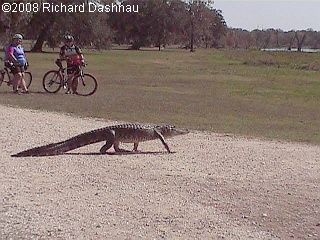 -
-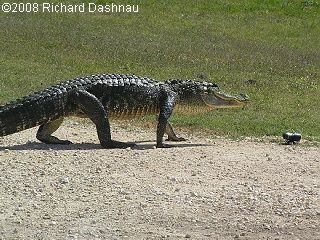 -
-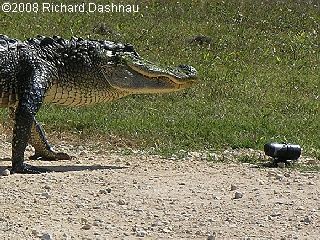
FRAMEGRAB
01
FRAMEGRAB
02
PHOTO
01
PHOTO
02
-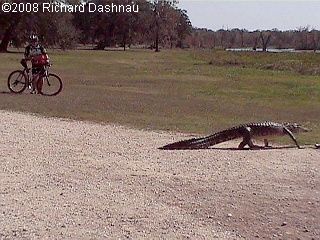 -
-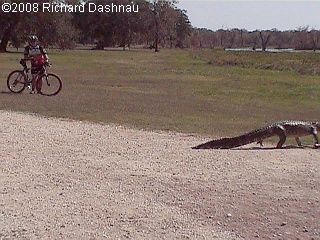
FRAMEGRAB 03
FRAMEGRAB
04
Finally,
here are images from the sport camera video. The camera is not on
any
tripod,
so it's hard to get it to lie straight. The idea is to be an
unintrusive
as possible. Although the alligator didn't walk right over the
camera,
I'm still happy with the results. I was lucky. Linked here are
three
video
clips. One at "human level"--from
the
tripod (5.4 mb); one from "gator level"--on
the
ground (4.7 mb) ; and one clip with the footage from the
two
cameras
edited together (8.0 mb) . I added a bit of music to
that one.
The video from the front clearly shows how the alligator's foot
makes a
horizontal arc as it moves back and forth during walking. Today's
RICKUBISCAM
shows the front leg moving forward just before the camera got
knocked
over.
I can't believe I was able to place the camera so the alligator
passed
so close!
 -
-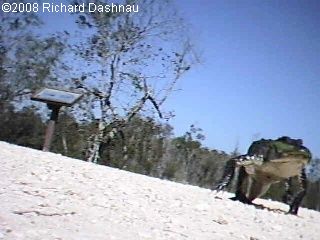 -
-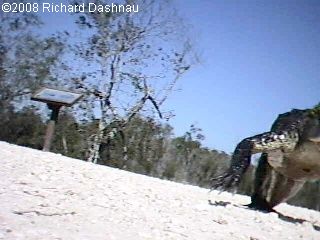 -
-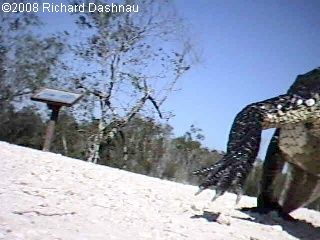 -
-
FRAMEGRAB
01
FRAMEGRAB
02
FRAMEGRAB
03
FRAMEGRAB
04
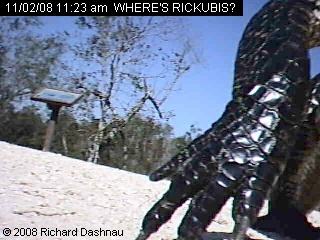
OLD RICKUBISCAM
Update
01/03/09--When I watched the video of the alligator coming towards
the
camera, I could see a big difference in the vertical alignment of
the
front
leg compared to the rear leg. Note how the femur, tibia/fibula,
and
foot
are in a straight vertical line in the back leg while the front
leg
swings
out to the side--and the humerus is out of line with the
radius/ulna
and
foot of the front leg (look at framegrab 04 above).
I was able to
find some interesting
ideas in this study:
LOCOMOTION
IN ALLIGATOR MISSISSIPPIENSIS: KINEMATIC EFFECTS OF SPEED AND
POSTURE
AND
THEIR RELEVANCE TO THE SPRAWLING-TO-ERECT PARADIGM
by
STEPHEN
M. REILLY AND JASON A. ELIAS
Department
of Biological Sciences, Ohio University, Athens, OH 45701, USA
This
study indicates that among "quadrapedal tetrapods" (A tetrapod is
an
animal
with 4 limbs, or one that has 4-limbed animals in its ancestry ( a
snake
is classed as a tetrapod); while a quadraped is an animal that
walks
on
four legs), crocodilians are unique for walking at varied
levels--sprawling
or
walking. It is generally thought that quadrapeds are grouped as
"sprawlers"--lizards
and amphibians; or "erect walkers"--mammals and dinosaurs;
with
crocodilians
being "semi-erect" because of the high-walk. It was also generally
thought
that crocodilians might represent some kind of evolutionary step
between
the two other modes of walking.
However,
this study indicates that the mechanics of the alligator "sprawl"
and
the
"high walk" are not really much different, and that the "sprawl"
is
actually
a sort of really low "high walk". (The alligator high walk has
been
defined
as a "walking trot". A "trot" is when a quadraped--such as a
horse--moves
forward by moving diagonal pairs of legs forward. (Right forelimb
moves
up at the same time as left hind limb, and then alternates.). The
alligator
moves
this way, but at a walking pace--hence "walking trot".
The
ancestors of alligators were actually bipedal digitigrades (this
means
that these creatures walked on TWO legs, and on their toes (this
isn't
odd. Lots of animals walk on
their toes. Dogs and cats do, so do
birds.))
Alligators now are quadrupedal plantigrades (they
walk on 4 legs,
and on the flats of their feet (the long bones of their
feet--metatarsals--are
parallel with the ground). Bears, raccoons,
and humans are also
plantigrades.).
So, the alligators method of walking is probably an adaptation
back
from
bipedalism, and so can't be used as a model for a possible
intermediate
method of going from a sprawling gait to
an erect
one.
5/18/2008--Walking
alligators. Here it is, near the end of alligator mating season
(March-May).
Alligators seems to have eased off bellowing--at least on the
mornings
that I go out to the park. But, I just might be getting there
after it
happens.
Temperatures have been rising, and I haven't seen large
numbers
of alligators upon the banks. Today, however, the alligators were
crossing
the trails quite frequently.
At around
11:40 am, I saw this alligator move to short wooden footbridge
at
40-Acre
Lake. After sitting under the bridge for about 15 minutes, it
walked
underneath
the bridge and entered Pilant Slough. The anigif below shows part
of
the
walk.

Then,
around 1:00pm, I was on the South side of Elm Lake, not far from
the
chemical
toilets. I had been watching a large alligator that had just
gotten
into
the water. There was another smaller alligator in the
water
nearby,
which seemed to have been driven off by this large one. A
group of
park visitors had stopped, and I was talking to them about
alligator
behavior.
I indicated the large one, and was describing how I expected
it to
climb
out of the water and lie along the bank. I had just spoken about
this,
and was saying how this alligator might be dominant in that
vicinity,
when
he (possibly "he" because of the size) climbed out of the
water--as if
on cue.
The
visitors got excited, and I was going to say something else about
his
movements,
when I noticed the he did NOT turn sideways, but just continued
walking
right towards my camera, and towards me! I'm always
entranced by
the slow, measured pace that a large unstressed alligator takes as
it
high-walks.
I couldn't remain entranced, because I believed
that the alligator
would have walked right through my tripod. I briefly
entertained the
thought
of letting him walk through it, but changed my mind and moved my
camera
(it would have fallen and gotten broken). The series of images
below
are
the frame captures from the video clip as
he moved towards me, and I
moved
the camera. And here is the link for the short
video clip (wmv 5.8mb).
-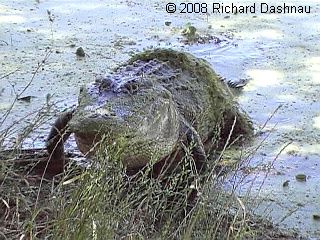 -
-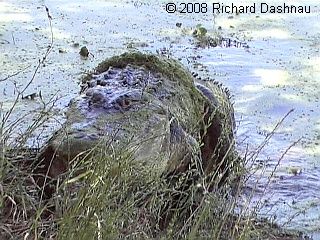 -
-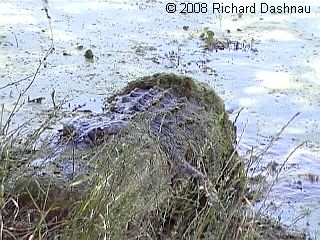 -
- -
-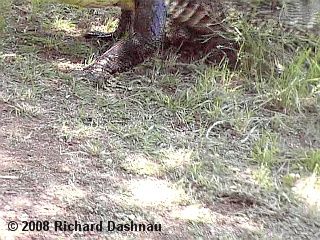
I
have
been at the park, and watching alligator movements and reading
about
them,
for about 8 years. On these very pages, I have posted clips of
them
walking
on land. Therefore, I'm speaking with some authority when
I say that I
knew that the alligator had absolutely NO interest in me at
all.
I could tell this from experience, and from reading the
alligator's
body
language.
Part
of my job at the park is to educate park visitors whenever
possible. In
some situations, this can be done through explanation. In others,
I
hope
to educate by example.
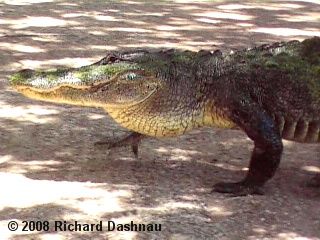
While
the alligator moved towards me, I moved slowly, and at the same
pace
that
he did. Although I had to reach towards
the alligator to get
my tripod, I took one step back, one step to the side, and one
step
towards
the camera--at
the same pace he was walking. Then I slowly (at the same
speed) picked up the tripod, stepped back and out of his path, and
set
the tripod back down. I did not speak. At all times that I was
still in
front of him, I kept full concentration
on his head and upper body. I
was
quite far from him (not within his reach) during all of this. By
watching
the head, I could verify that he was not tracking me.
An alligator
is most comfortable in the water. It's the alligator's shelter,
its
food
source, and its communication medium. An alligator is more
vulnerable
on
land, even though it will lie on it, or walk over it. Even a
large
alligator on land is more likely to be defensive. By moving
at the same pace as the
alligator, I didn't send possible visual cues
that
would cause a defensive reaction. By not speaking, I didn't set
off any
auditory alarms, either. Once I was out of his path, I did not
move any
more. By remaining by my tripod, I probably
presented a more stationary
profile. On the alligator's end, I suspect (by observation--I have
not
verified by reference) that the larger alligators do assert more
dominent
traits--such as walking as though everything else will give way.
Therefore,
the alligator "decided" that it was going to cross the trail, and
I
would
give ground. Once I was out of the alligator's path, I definitely
held
no interest for it, and I could film at my leisure. Unfortunately,
I
had
my cameras
zoomed to film him a bit further away, so everything is
quite
close.
I could
have moved further back, but I wanted to limit all
movement--especially
of something as large as my legs--once I got out of his way.
While
I was filming on my
side, some of the park visitors were filming also.
Some of them were nice enough to get together and send me a
picture of
the crossing from their viewpoint. I'm hoping they'll sent their
short
clip, too. What's important is that they sent
the photo, and gave me
permission
to use it. I was told that giving them credit was unncessary--so
I'm
not
going to name anyone here. A BIG thanks to you all, though!
Today's
RICKUBISCAM
is cropped from the photo. Below is the
full shot, resized for this
page.
--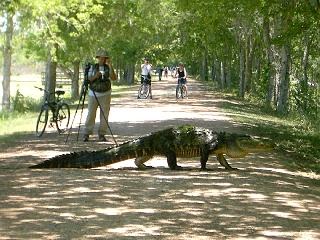 ---
---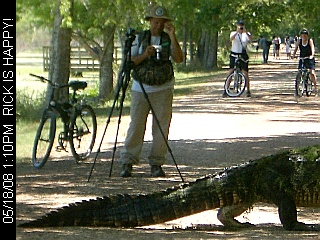
The
alligators are a big reason that many visitors come out to our
park.
They
are the biggest reason I began to volunteer there. The alligators
are
beautiful,
majestic, complex creatures. It gives me a thrill every
single
time
I see one walk by me. By exercising care and giving the respect
due to
all animals, all visitors to the park could potentially enjoy such
a
sight.
The most important point is to stay clear of the alligators, and
follow
the park signs. Do NOT approach them, do NOT feed them, do NOT
harass
them.
The alligators, like all the wildlife at the park, have
priority.
Sometimes, just staying clear isn't enough, because animals move,
after
all.
Just using a little common sense, keeping a clear head, and
showing
consideration for all life forms; sometimes one can have a
wonderful
interaction
with living wild creatures. By following these simple
guidelines,
everyone who visits the park can enjoy sights like these and can
insure
that other people will enjoy them as well. Listen closely to
the
video clip. Near the end, amongs the excited exclamations, there's
a
male
voice
saying something like "It was worth the drive out here just to
see
that!"
He's certainly right. I see something worth the drive every time I
go
out
there.
Not
too long (maybe 15 minutes) after this crossing I heard a headslap
on
that
side of the trail. I slowly moved towards where I thought the
sound
came
from. At about 1:30 (about 20 minutes after the big one
crossed),
another
alligator (it looked a bit smaller than the first one) crossed the
trail
from Pilant Slough into Elm Lake. I turned and was just able to
catch
the
end of the crossing. It crossed right next to the pier. The anigif
below
shows the pictures I shot.
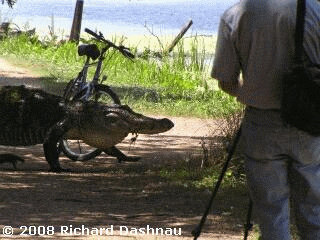
10/22-10/29/2006-ALLIGATOR
PARTY!--BBSP recieved a
large amount of rain the week before October 22 (which was a
Sunday).
This
caused water to flow over parts of the park that have been totally
dry
for a time that
could extend from 3 months to over a year. When this
water
eventually made its way through Old Horseshoe Lake and into New
Horseshoe
lake, it carried large amounts of silt and decaying material. This
caused
a probably
oxygen depletion in New Horseshoe Lake which--in
turn--caused
a massive fish kill. Large numbers of dead and dying fish appeared
at
the
surface of the lake.
And
the alligators began feasting.
-------------------------------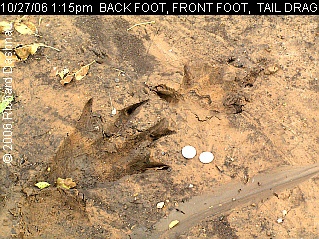 -
-
Somehow,
news of this occurrance spread through the alligators in the park
(perhaps
it was the odor of decaying fish; or maybe even the sound of
alligator
jaws working, and predatory splashing which carried the
news)
and a
massive
alligator picnic came into being for most of the week between
10/22 and
10/29.
Although
I was at the park for most of that week, I was attending some
training,
and didn't have time to observe anything until
Friday
(10/27). What
a sight! During that week we had a cold front pass through (with a
LOT
more rain). The cool air, and the rain dropped the temperatur of
the
air
and the water. The engorged alligators, seeking heat
(thermal energy)
to
help them digest, massed on the banks of New Horseshoe lake to
absorb
solar
energy. I could see some alligators near the benches of the far
bank,
so
I walked towards them. When I crossed a low
point, I found some
alligator
prints (and tracks from other animals as well!)--really LARGE
alligator
prints. The image above shows a back footprint and front footprint
with
2 quarters for scale. The first picture below
(PRINTS CLOSER)
is a little better shot. Alligators have 4 toes on the rear feet,
and 5
toes on their front feet. Of these, only the three inner toes
(those
closest
to the body) have claws on them. Look at the footprints,
and you can
see
the deep marks made by the claws.
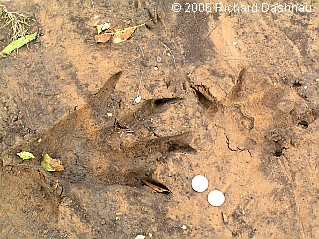 --
--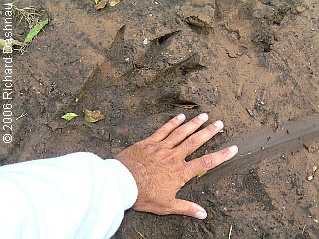 --
--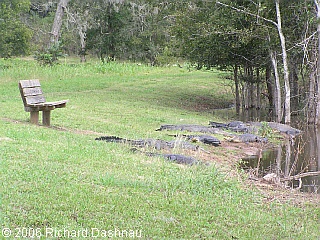 --
--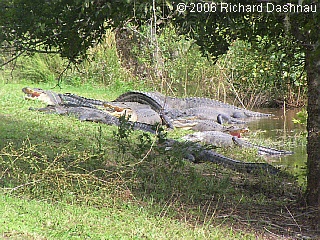 --
--
PRINTS
CLOSER
PRINTS AND MY HAND
INTERESTING
BENCH VIEW
ANOTHER, BIGGER
PILE!

REALLY FULL ALLIGATOR
I rounded
the curve, and cresting the small rise, I could see the bench, and
in
front
of it there were eleven alligators (see INTERESTING BENCH, above).
I
moved
slowly past the rear of the bench, moving slowly and
quietly. About 30
feet past the first pile, there was another pile of
about 14 more
alligators! (see ANOTHER BIGGER PILE, above). I just stood there,
enjoying
the company of this mass of reptiles. Some of them gaped,
some changed
position. I took some pictures. Behind me, about 50 feet away,
there
was
a large flock of Ibises feeding in the marshy grass. Something
spooked
them after about 10 minutes, and they all took off,
splashing and
flapping.
The noise startled the alligators, and some of them moved into the
water.
After
some time, they began to climb back onto the shore. Remember, they
needed
that sunlight! I took a picture of this one as it hauled itself
back up
onto land. (see REALLY FULL ALLIGATOR, above.) Look at that
swollen
belly!
There's a LOT of fish in there.
Sunday,
10/29, was another great day. By then, the fish were gone. That
interesting
dead fish odor was gone. The alligators were still there basking,
though.
I watched a couple
park visitors near one of the benches and got this
great
picture. (See WHAT DO THEY SEE?, below) The two women are looking
off
into
the woods; and it appears that the alligator is watching them,
wondering,
"What
are they looking at?". Here's a bigger
version of the same image. As the day wore on, more Park
Staff and
Volunteers appeared in the area, partly to be sure that all
human/alligator
interactions were peaceful; and just
because the alligators were there.
Here's Chuck, one of the volunteers, monitoring the area near the
benches
(see KEEP YOUR DISTANCE, below).
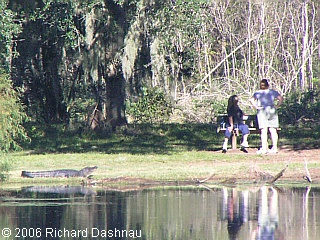 --
--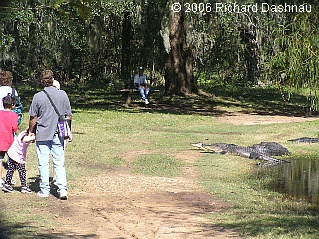 --
--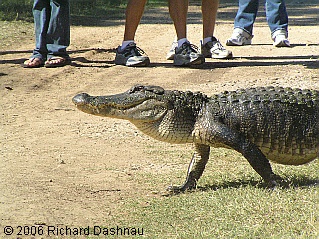 --
--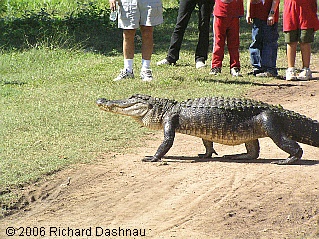 ---
---
WHAT
DO THEY
SEE?
KEEP YOUR DISTANCE
PASSING THROUGH
1
PASSING THROUGH
2
WHAT
DO THEY SEE? 640
PASSING
THROUGH? 640
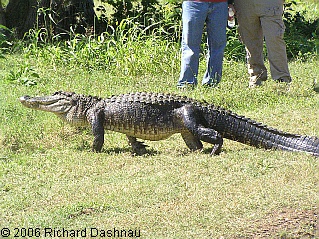
PASSING THROUGH 3
After
a few hours, the "first basking shift" began returning to the
water as
they got warm. However, it was evidently time for some of the
alligators
to leave the party. At about 1:30pm, one of the basking
alligators-instead
of
returning to the water-walked uphill and crossed the trail (see
PASSING
THROUGH 1-3 above, and 4-5 below). This is always a thrill
for me.
I'm always watching the alligators near me, and by its body
language, I
knew the
alligator would be coming my way. I cleared the people from
its
path, and the alligator just kept walking. We want to keep a clear
field
in front of the alligators. An alligator is vulnerable out of the
water,
and confronting or
bothering it could cause it to stand its ground or
begin
defensive behavior. We don't want this. This alligator
walked
through
the grass and into a shallow extension of Pilant Lake.
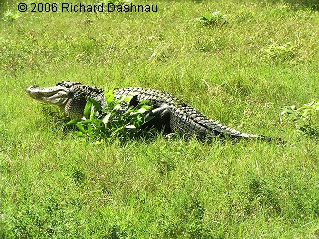 --
--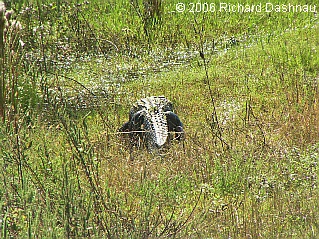 --
--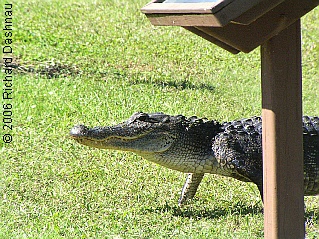 --
--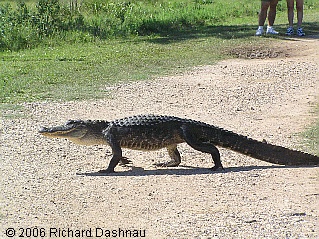 ---
---
PASSING
THROUGH
4
PASSING THROUGH 5
SIGNAGE TOUR 1
SIGNAGE TOUR2
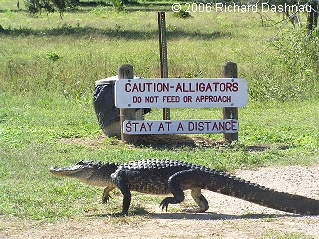
SIGNAGE TOUR
3 SIGNAGE
TOUR 3 640
About
an hour later, another alligator decided to leave
the party. I noticed
this one while it was still in the water, and I knew it was
examining
the
bank above it. I was talking about that alligator to some
visitors
when it started walking
out of the water. Then, it passed right by the
display plaque, and one of our "CAUTION, ALLIGATORS" signs. (see
SIGNAGE
TOUR 1-3 above, 4-7 below) This alligator turned and went into Elm
Lake.
As I did before, and always,
I made sure that all humans were out of
the
alligator's path.
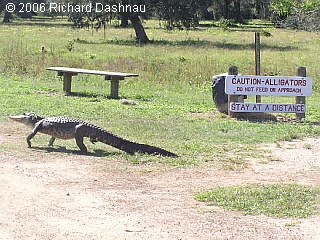 --
--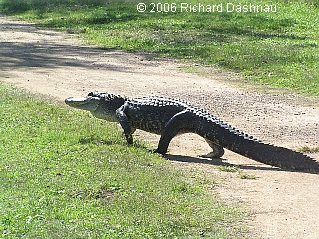 --
--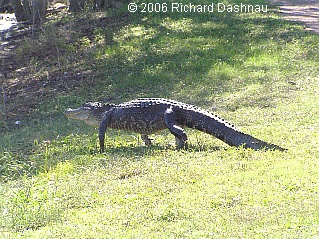 --
--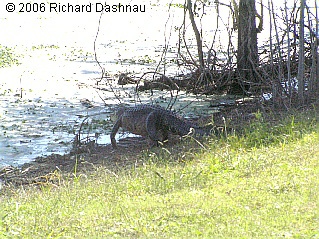 ---
---
SIGNAGE
TOUR
4
SIGNAGE TOUR
5
SIGNAGE TOUR
6
SIGNAGE TOUR 7
It's
been wonderful to see so much water return to the park.
And,
this page shows
alligators at the park, on land, near various landmarks at the park.
Go back to my
main alligator page, Alligators
Go
back to my home page, Welcome
to
rickubis.com
Go
back to the RICKUBISCAM
page.
Go
back to the See
the
World
page.




























































































